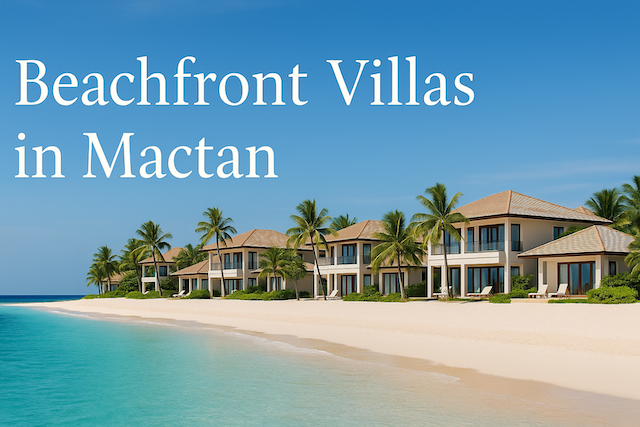Beachfront Villas in Mactan: A Buyer’s Guide

Contents
- Beachfront Villas in Mactan: A Buyer’s Guide
- Introduction
- 1. Why Mactan Island?
- 2. Types of Beachfront Villas
- 3. Popular Areas for Beachfront Villas
- 4. Legal Considerations for Foreign Buyers
- 5. Costs Involved
- 6. The Buying Process
- 7. Pros and Cons of Buying a Beachfront Villa in Mactan
- 8. Investment Potential
- 9. Lifestyle Benefits
- 10. Tips for Buyers
- Conclusion
- Frequently Asked Questions: Beachfront Villas in Mactan
- 1. Why are beachfront villas in Mactan popular among buyers?
- 2. Can foreigners own beachfront property in Mactan?
- 3. What is the typical price range for beachfront villas in Mactan?
- 4. What are the best areas to buy beachfront villas in Mactan?
- 5. What are the ongoing costs of owning a beachfront villa?
- 6. Is buying a beachfront villa a good investment?
- 7. Can I use my villa for short-term rentals like Airbnb?
- 8. What legal documents are needed during the purchase process?
- 9. How long does the purchase process usually take?
- 10. Are beachfront villas safe from flooding or typhoons?
- 11. Do I need a local bank account to buy property?
- 12. Can I build my own beachfront villa?
- 13. How do I verify if a beachfront villa has a clean title?
- 14. Are there property taxes for villas in the Philippines?
- 15. What kind of lifestyle can I expect living in a beachfront villa?
- 16. Is internet and mobile connectivity reliable in Mactan?
- 17. What are the risks of beachfront ownership?
- 18. Can I finance my beachfront villa purchase?
- 19. Are there any environmental rules I should be aware of?
- 20. Who should I consult before buying?
Beachfront Villas in Mactan: A Buyer’s Guide
Introduction
Mactan Island, located just off the coast of Cebu in the Philippines, is a tropical haven known for its crystal-clear waters, world-class diving spots, and luxurious beachfront properties. For years, it has attracted a growing number of foreign and local investors looking to own a piece of paradise. Among the most coveted assets are beachfront villas—offering not just comfort and luxury, but also excellent investment potential. This guide is designed to provide potential buyers with an in-depth understanding of what it takes to buy a beachfront villa in Mactan.
1. Why Mactan Island?
a. Prime Location
Mactan is connected to mainland Cebu by bridges, making it highly accessible. The Mactan-Cebu International Airport is just a 15–30 minute drive from most beachfront areas, which adds immense convenience for international travelers and investors.
b. Booming Tourism and Infrastructure
With the increasing number of tourists and government-backed infrastructure projects (such as the Cebu–Cordova Link Expressway), Mactan has seen rising demand for luxury accommodations and second homes.
c. Stable Property Market
Real estate in Cebu Province, including Mactan, has shown consistent appreciation over the past decade. Beachfront properties, especially, remain resilient and are considered valuable long-term investments.
2. Types of Beachfront Villas
Beachfront villas in Mactan vary in style, price, and amenities. Buyers can choose from:
-
Stand-alone luxury villas: Often part of gated communities or private estates.
-
Resort-affiliated villas: Located within resorts, offering full access to hotel facilities.
-
Modern townhouses or duplexes: A more affordable entry point into beachfront living.
-
Custom-built properties: Tailored to the buyer’s specifications on purchased land.
3. Popular Areas for Beachfront Villas
a. Punta Engaño
Home to high-end resorts like Shangri-La, Mövenpick, and Dusit Thani. Villas in this area are premium-priced and often include access to five-star amenities.
b. Maribago and Marigondon
These central areas have a mix of mid- to high-end villas, often popular among expats and local executives.
c. Cordova
An emerging area that is benefitting from infrastructure developments. More affordable beachfront properties can be found here, with rising appreciation potential.
4. Legal Considerations for Foreign Buyers
a. Can Foreigners Own Land in the Philippines?
Foreigners are prohibited from owning land directly but can own structures. There are workarounds:
-
Lease Agreements: Long-term lease (up to 50 years, renewable for another 25) with landowners.
-
Filipino Spouse Ownership: If married to a Filipino, the property can be titled under the spouse’s name.
-
Corporation Ownership: A Philippine-registered corporation (with at least 60% Filipino ownership) can legally own land.
b. Condominium Act
Foreigners can own up to 40% of a condominium project. While villas are usually stand-alone, some resort-affiliated villas may fall under this classification.
5. Costs Involved
a. Purchase Price
Beachfront villas typically range from ₱15 million to over ₱150 million, depending on size, location, and finish.
b. Taxes and Fees
-
Capital Gains Tax (6%)
-
Documentary Stamp Tax (1.5%)
-
Transfer Tax (0.5–0.75%)
-
Notarial and registration fees
Total transaction costs are usually 7–9% of the property price.
c. Maintenance Costs
Expect to pay for:
-
HOA fees (if inside a subdivision or resort)
-
Security and landscaping
-
Utilities (water, power, internet)
-
Property management (optional, but common for absentee owners)
6. The Buying Process
a. Property Search
Work with reputable brokers or developers. Many listings can be found through online portals or through on-site visits.
b. Due Diligence
-
Verify ownership titles
-
Ensure zoning permits and building compliance
-
Check for any liens or encumbrances
c. Offer and Negotiation
Once a suitable property is found, make a written offer and enter into negotiation with the seller.
d. Contract Signing
A Contract to Sell (CTS) or Deed of Absolute Sale (DOAS) is executed once payment terms are finalized.
e. Transfer of Title and Registration
Usually handled by a lawyer or title company. This can take several weeks to months depending on document completeness.
7. Pros and Cons of Buying a Beachfront Villa in Mactan
Pros
-
Beach lifestyle: Daily access to sand, sea, and sun.
-
Rental income: Potential for Airbnb or long-term rental yields.
-
Investment value: High appreciation potential in prime locations.
-
Privacy and luxury: Enjoy personal space in a secure and serene environment.
Cons
-
Maintenance: Saltwater exposure increases wear and tear.
-
Weather risks: Being in a typhoon-prone region.
-
Legal complexity: Especially for foreign buyers.
-
Costs: High upfront and ongoing expenses.
8. Investment Potential
a. Rental Income
Mactan is a major tourist destination. Short-term rentals, particularly beachfront properties, command premium rates—especially during peak season (November to May).
b. Capital Appreciation
Properties in areas like Punta Engaño and Cordova have appreciated 5–10% annually in recent years. Future infrastructure developments may further boost values.
c. Resale Market
Demand is strong among both locals and foreigners. Well-maintained beachfront villas are rarely on the market for long.
9. Lifestyle Benefits
a. Water Sports and Recreation
Scuba diving, snorkeling, paddle boarding, and island hopping are just outside your doorstep.
b. Community
A mix of locals, expats, and tourists creates a culturally rich and dynamic environment.
c. Health and Wellness
Beachfront living promotes an active lifestyle and offers mental wellness benefits due to proximity to nature.
10. Tips for Buyers
-
Engage a local attorney for contract review and due diligence.
-
Inspect multiple properties before committing.
-
Understand the limitations if you’re a foreign buyer—especially regarding land ownership.
-
Plan for long-term maintenance and management, especially if you don’t live in the Philippines full-time.
-
Look for clean titles and properties with complete documentation.
-
Evaluate HOA rules if buying inside a subdivision or resort.
Conclusion
Buying a beachfront villa in Mactan is more than just acquiring a luxury property—it’s an investment in lifestyle, health, and long-term value. While the legal landscape requires careful navigation, the rewards are substantial. Whether you’re seeking a second home, a retirement sanctuary, or a cash-generating rental property, Mactan’s beachfront villas are among the best in Southeast Asia.
With rising demand, improving infrastructure, and the timeless appeal of oceanfront living, now may be the perfect time to make your move.
Frequently Asked Questions: Beachfront Villas in Mactan
1. Why are beachfront villas in Mactan popular among buyers?
Mactan offers pristine beaches, direct airport access, and growing tourism infrastructure. Beachfront villas provide not only luxurious living but also high potential for rental income and property appreciation.
2. Can foreigners own beachfront property in Mactan?
Foreigners cannot legally own land in the Philippines but can own structures such as villas. Many buyers use long-term leases, marry a Filipino citizen, or invest through a corporation with at least 60% Filipino ownership to acquire beachfront villas.
3. What is the typical price range for beachfront villas in Mactan?
Prices typically range from PHP 15 million to PHP 150 million or more depending on location, land area, beach access, and included amenities. Premium areas like Punta Engaño command higher prices.
4. What are the best areas to buy beachfront villas in Mactan?
Punta Engaño (luxury market), Maribago and Marigondon (mid-range and resort living), and Cordova (upcoming development zone) are among the most recommended areas for beachfront investments.
5. What are the ongoing costs of owning a beachfront villa?
Ongoing costs include property taxes, association dues, security, landscaping, utilities, and optional property management fees. Maintenance costs are higher near the sea due to saltwater exposure.
6. Is buying a beachfront villa a good investment?
Yes. Villas in prime locations can generate significant rental income and show strong appreciation. With Mactan’s growing infrastructure and tourism, long-term value remains solid.
7. Can I use my villa for short-term rentals like Airbnb?
In most areas, yes—especially if the property is not under restrictive homeowners’ association (HOA) rules. Some resort-affiliated villas may require revenue-sharing agreements or prohibit short-term rentals.
8. What legal documents are needed during the purchase process?
Key documents include the Transfer Certificate of Title, Deed of Absolute Sale, tax declarations, and updated tax receipts. Due diligence and legal assistance are strongly recommended to verify documentation and ownership.
9. How long does the purchase process usually take?
Once an agreement is reached, the process can take 30 to 90 days depending on title clearance, document completeness, and municipal registration timelines.
10. Are beachfront villas safe from flooding or typhoons?
Mactan is occasionally affected by typhoons. It’s important to check flood zoning, elevation, and ensure that the villa has appropriate storm protection measures like breakwalls, drainage, and reinforced roofing.
11. Do I need a local bank account to buy property?
Not necessarily, but having a Philippine bank account makes payments (like taxes, utilities, and repairs) more convenient. Some developers or sellers may prefer bank-certified buyers.
12. Can I build my own beachfront villa?
Yes, if you lease land or purchase through a corporation, you can build your own villa. You will need to secure building permits, architectural plans, and comply with zoning and environmental regulations.
13. How do I verify if a beachfront villa has a clean title?
Request a certified true copy of the title from the Registry of Deeds and verify it through a lawyer or licensed broker. Ensure there are no liens, encumbrances, or disputes attached to the property.
14. Are there property taxes for villas in the Philippines?
Yes. Property owners must pay annual real property tax (RPT), which varies depending on the property value and municipal rates. Late payments incur penalties, so it’s crucial to stay current.
15. What kind of lifestyle can I expect living in a beachfront villa?
Expect a laid-back, nature-rich lifestyle with access to water sports, fresh seafood, and spectacular ocean views. Many expats and retirees find the quality of life in Mactan exceptional and relaxed.
16. Is internet and mobile connectivity reliable in Mactan?
Most developed areas in Mactan have strong fiber internet and mobile networks. Villas near resorts or major residential areas generally enjoy good connectivity.
17. What are the risks of beachfront ownership?
Risks include climate-related issues (flooding, erosion), maintenance challenges, and legal complexities. These can be managed through proper property selection, insurance, and professional management.
18. Can I finance my beachfront villa purchase?
Yes, some Philippine banks offer loans to foreigners with special visas or those with Filipino spouses. Developers may also offer in-house financing, though with shorter terms and higher interest rates.
19. Are there any environmental rules I should be aware of?
Yes. Beachfront development is regulated to protect marine ecosystems. Building too close to the shore without DENR (Department of Environment and Natural Resources) clearance may result in penalties or demolition.
20. Who should I consult before buying?
Engage a licensed real estate broker, a local lawyer familiar with land laws, and if needed, a property inspector. Their guidance can prevent costly mistakes and ensure a smooth purchase process.




